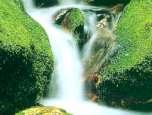The Alps are a kind of Fort Knox of European water reserves, with enormous quantities of water collected in a watershed of 143,000 square kilometres and crossed by watercourses carrying down to the valleys the amazing volume of 200 billion cubic metres of “blue goldâ€. A major resource to be used wisely, since this reserve of water is the first to feel the effects of global warming (the snow cover and the glaciers are not what they once were – they already contain half the volume they had in 1850.) All the same, this drinking water resource of the Alps is still very large – and often wasted. In European countries the average water loss has been estimated at around 30 %, with peaks of 70-80% in some cities. Only 2% of drinkable water is actually used for human consumption. So far, the Alpine Convention has not produced any great results. The European Directives of 17 February 1998 recommend an “integrated and sustainable management of aquatic environmentsâ€. In Italy, the 1994 Galli Act imposes a “level of flow necessary to life in river beds…â€. A similar requirement is imposed by the law which set up watershed authorities. But what is the situation like today? Nine years after Law 36/94 was passed, the development of the market as regards water services in Italy has largely remained on the drawing board. The excessive fragmentation which existed has not been eliminated: there are still 8,100 water service bodies of various kinds operating in the sector. The Galli Act envisaged the division of the territory into 84 areas; in many of these an authority has not yet been set up, and even where this is the case, not all the authorities have completed a survey of the work required. In most areas where a decision has been taken as to the type of management to be implemented, the Public-Private partnership system has been chosen.
The decision has rarely been taken to put the work out to tender. In areas where a survey has been made, it has been found that losses from the water system are between 20 and 40%. The managing bodies are usually small companies without sufficient funds for investment. The result is that 98% of the population depend on waterworks with a low quality of service. 34% of the population served do not have sufficient water; 44% do not drink tap water.
The problems, and the opportunities, connected with the “water economy†in the Alps and in mountain areas in general are an important point, especially in a province such as Verbano-Cusio-Ossola, where water has been a decisive factor in the local life and economy, from the birth of the textile industry to the harnessing of hydro-electric power.
The issues involved range from systems for optimising the regime to the management of quality water for drinking, from hydro-electric schemes which will help to make up the alarming deficit of electric power in the Alps (almost 50% in Piedmont), to the sporting activities which depend on lakes and rivers.
The Alpine system produces almost 50 billion sq. mt. of water, an immense natural resource which, at least partly, can be transformed into an economic resource.
What should be done? Along with encouraging models for the consumption and distribution of energy which aim at efficiency, economy and the lowest possible environmental impact, methods should be developed for producing energy from renewable sources, which could also consist of “short†economic filiere, as in the case of wood. The regions, provinces and local bodies should be encouraged to start up projects for specific purposes which would see the involvement of private backers.
Nobody can deny that these are “mountain resourcesâ€; but the fact is that the mountains receive practically nothing in return. The regions of north-western Italy together produce at least 30 billion cubic metres of water, more than half of which flows unused into the sea. But the value of the part which is actually used varies according to the end consumer. One cubic metre of water for agricultural use is worth a few cents; this rises to 45/80 cents for industrial and drinking purposes, and to 200/300 euros per cubic metre for mineral water.
There are regional laws regarding the water cycle (e.g. in Piedmont, Law no. 13 of 1997) which set a minimum return of 3% for mountain communities on the final value of drinking water.
In enforcing this law, the 8 provinces of Piedmont have the option of going beyond this threshold percentage; for example, in Cuneo the proportion of “return†to the mountain areas has been set at an advantageous 8%. This possibility envisaged by the law should find a more general application.
Still on the topic of “financial returnâ€, there should be a revision of the rules governing the stake of local district councils in hydro-electric power consumption in favour of the councils. There is also a need for setting area water tariffs which provide for reductions for mountain areas, even to the point of exempting them entirely from paying for the water which, after all, they themselves produce.
Another problem linked to the water cycle is that of the hydrogeological stability of the territory, which in an Italian context is of major importance.
The fact that mountain areas have been largely abandoned by their populations has put an end to the widespread maintenance of the territory which was once the norm, and is regarded as a prime (though not the only) cause of the geological instability now so prevalent in Italy, and which should be the focus of greater attention.
A study by the Geology Department of Piedmont Region reveals that there were 4334 episodes of environmental disruption in Piedmont between 1850 and 1999. There is a sharp increase in the intensity of disruptive episodes from about 1950 on. The maximum peak is still the flooding which occurred in 1994, but the damage caused in the last ten years has been calculated at more than € 5 billion, an average of more than € 500 million per year. This makes Piedmont one of the regions most susceptible to environmental damage in Italy.
It is self-evident that if this figure (or even far less) were to be spent on preventing instead of only on making good the damage, three levels of major results could be achieved: the territory could be made safe; an economy of geological safety might be developed, with positive repercussions for employment in the area; the water resources would function and be used better.
(Marco Travaglini, Spokesperson on Mountain Areas of the Party of the Democrats of the Left – DS)



